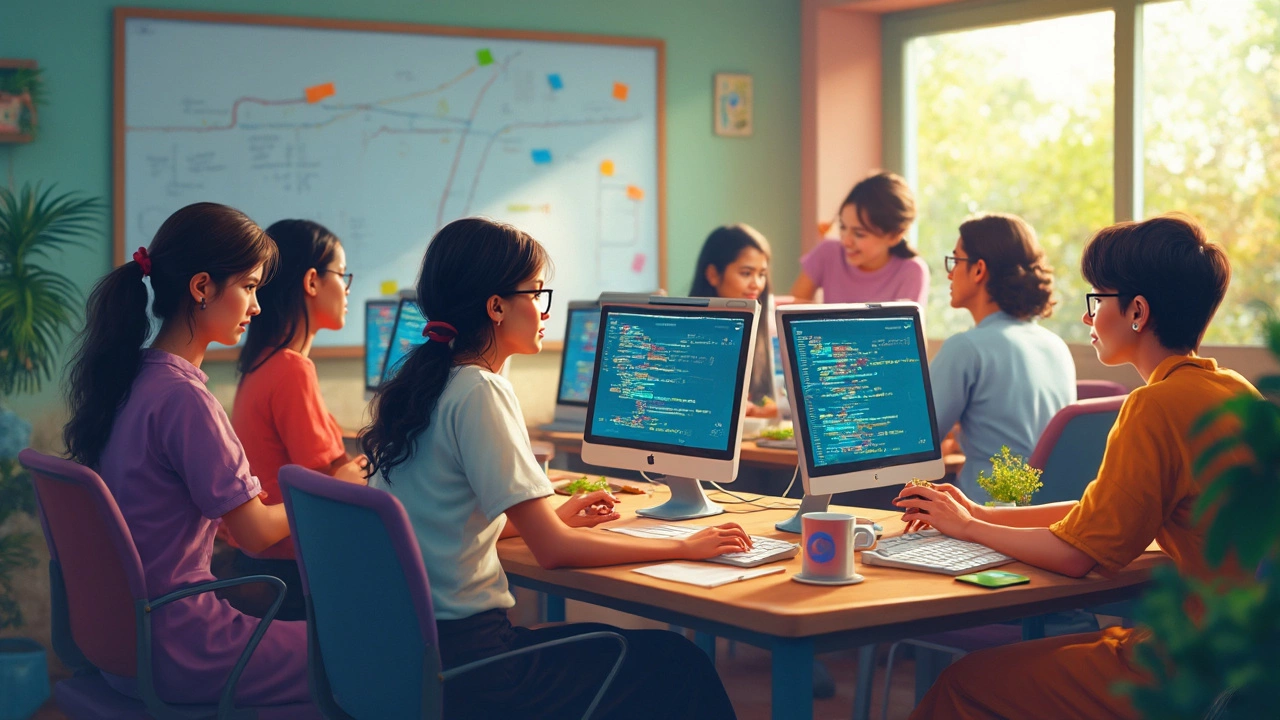Most people toss around the words "coding" and "programming" like they’re the same thing—kind of like calling all sodas "Coke." But here’s the deal: there’s actually a big difference, and knowing what sets them apart can save you tons of time and money when you’re jumping into tech.
If you Google these terms, you’ll see lots of vague answers and debates. But for folks just starting out or thinking about taking a coding class, you don’t need the academic fluff. What you really want to know is what you’ll be doing day-to-day, right?
You might hear that "coding" is just about translating what you want a computer to do into a language it understands—like giving step-by-step instructions. "Programming," though, goes a step further. It’s about thinking through the whole process: planning, designing, testing, problem solving, and then actually coding. Almost like the difference between writing a grocery list and running a whole restaurant.
Fun fact: Some of the world’s most famous apps started with someone just coding away, but they only took off when a real programming mindset came into play—organizing, debugging, making sure everything worked together perfectly. Want to figure out where you fit best? Let’s break it all down in simple, everyday terms.
- Coding: What It Actually Means
- Programming: It’s More Than Writing Code
- Where Coding Stops and Programming Starts
- Real-World Examples and Common Misunderstandings
- Tips for Choosing the Right Path
Coding: What It Actually Means
When people talk about coding, they usually mean writing instructions that a computer can follow. Think of it like texting commands to your phone, but instead of emojis and shorthand, you use a specific language like Python, JavaScript, or C++. The goal? Tell the computer exactly what to do, step by step. If you mess up the instructions, the computer won’t smile and guess what you meant—it’ll just spit out an error.
Most beginners start their coding journey with simple tasks, like printing “Hello, World!” on the screen. This is classic stuff you’ll find in most beginner guides. But even at this basic level, you’re learning how to solve problems with code.
If you want to know what coding looks like up close, picture this: you break a big task into smaller pieces, write out instructions for each piece, and then translate those steps into code. Here’s a super basic example in Python:
print("What’s your name?")
name = input()
print("Hello, " + name)
That’s it—you just coded up a tiny program. Nothing fancy, but it’s real!
Here’s why coding matters:
- It teaches you how computers "think."
- It’s the fastest way to automate boring stuff—like sorting your music playlist or renaming a ton of files at once.
- It’s the foundation for bigger things in software development.
A lot of coding jobs, especially entry-level ones, focus on churning out clear, bug-free code that someone else has already designed. For example, web developers often get assigned specific features and code them up according to a plan.
| Top Coding Languages (2024) | Used For |
|---|---|
| Python | Web apps, automation, data science |
| JavaScript | Websites, interactive pages |
| Java | Mobile apps, enterprise software |
The main thing about coding: it’s incredibly concrete. You know right away if you got it right—your code runs, or it doesn’t. No guesswork, just results. That instant feedback makes it great for learning and super satisfying when you nail it.
Programming: It’s More Than Writing Code
You might think programming is just about typing lines of code, but it covers a lot more ground. At its core, programming is about solving real problems—sometimes before you even start writing any code at all. It includes planning what needs to be done, thinking through every possible snag, and making sure the whole thing works smoothly from start to finish.
Here’s a kicker: while coding is about giving the computer exact instructions, programming is about figuring out the bigger plan and turning ideas into working software. For instance, a programmer will draw up diagrams, figure out how parts of a project fit together, and catch bugs before they even pop up.
Steve Jobs once nailed it in an interview when he said:
“Everybody in this country should learn to program a computer, because it teaches you how to think.”
Programming pushes you to break a problem into steps, think about what could go wrong, and come up with backup plans. Debugging takes up a huge chunk of the job. Some surveys even show that programmers spend about 50% of their time finding and fixing problems, not just adding new features. Check out this data from a study published in IEEE Spectrum:
| Task | Average Time Spent (%) |
|---|---|
| Debugging | 50% |
| Writing New Code | 35% |
| Design & Planning | 15% |
Here’s what programmers actually do beyond just coding:
- Plan how all the pieces of a software development project will work together.
- Break big problems into smaller, manageable tasks.
- Write and organize code so others can understand and work with it later.
- Test, debug, and fix mistakes as they show up.
- Think about security, performance, and long-term updates from the get-go.
If you’re taking coding classes, you’ll want to look for ones that don’t just teach you how to write code, but also how to plan, test, and manage whole projects. That’s the real jump from coding to programming, and it’s what sets you apart in any tech job.

Where Coding Stops and Programming Starts
Coding is that nitty-gritty process of writing instructions in languages like Python, JavaScript, or C++. You follow clear rules and syntax—think of it like filling out forms with specific answers. You’re telling the computer exactly what to do, step by step. This is usually the part beginners do in their first coding classes: looping through numbers, checking if something is true or false, or printing text on a screen.
But programming? That’s when things get way more interesting—and more challenging. You’re not just telling the computer what to do; you’re actually figuring out what to do in the first place. The job expands to planning, designing how all the pieces should fit together, and fixing problems before they even pop up.
Here’s where the wall appears:
- Coding is about writing lines of code—clear and simple. Think of copying a recipe.
- Programming pulls back the camera. Now you’re deciding which recipes go well together, what ingredients you’ll need, maybe even inventing your own dishes.
In a real job or project, you’ll probably start as a coder. Over time, you’ll be expected to think like a programmer—troubleshooting tricky bugs, designing how users interact, and keeping everything running smoothly. A basic coder might get a simple task and finish it. A programmer will ask, “What problem am I solving? Is there a better (or faster) way?”
Take password checkers. Coding is building a box that checks if a password matches. Programming is figuring out what makes a strong password, how to warn users, how to keep hackers out, and how to upgrade your system when threats change.
Here's a quick snapshot showing the main differences and where they cross over:
| Task | Coding | Programming |
|---|---|---|
| Writing syntax | Always | Always |
| Debugging | Basic fixes | Hunting for deep issues |
| Planning features | Rarely | Always |
| Designing systems | No | Yes |
Most people start with coding because it’s hands-on and practical. But if you want to build apps, websites, or anything bigger than a calculator, you’ll eventually need those broader programming skills, too.
Real-World Examples and Common Misunderstandings
Let’s clear up what actually happens in real life when people talk about coding and programming. It’s pretty common for folks to use these terms the wrong way—even in job postings! You’ll see ads asking for a "coder" when they really want someone who can handle the full package of software development.
Say you’re working at a small business, and your boss asks you to fix the company’s website so it loads a new logo. If you know some HTML or CSS, you can just jump in and change a few lines. That’s coding—quick, direct, not much thinking about big problems. But if you’re asked to build a custom booking system? Now you need to plan how data gets stored, how users will log in, what happens if something breaks, and how everything connects. That’s classic programming, not just writing lines of code, but figuring out how every piece fits and how to handle stuff when things go wrong.
Here’s a relatable breakdown:
- Coding: Making a simple calculator app by following a set of instructions from YouTube. You type the code, make sure it runs, and call it a day.
- Programming: Designing a full budgeting tool from scratch. You decide what features to include, how users add expenses, how reports are generated, and you find and fix mistakes along the way.
One big misunderstanding is thinking that learning to code alone makes you a programmer. Not always. Knowing a bunch of coding languages is awesome, but programming needs you to solve real-life problems and sometimes lead a project start to finish.
Just for a peek at workplace reality, check this out:
| Task | Coding | Programming |
|---|---|---|
| Fixing a broken button | ✔️ | — |
| Building an e-commerce site from scratch | — | ✔️ |
| Adding a new page to a website | ✔️ | — |
| Creating a system for order tracking and notifications | — | ✔️ |
So, next time you see a job ad or sign up for coding classes, take a closer look. Are you just picking up a coding language, or are you learning how to think like a programmer? Understanding this can help you figure out where you want to go in tech—and avoid falling for buzzwords that don’t really tell the full story.

Tips for Choosing the Right Path
Picking between coding and programming depends a lot on your goals and how deep you want to go in the world of tech. If you’re just getting started and are a bit nervous, basic coding classes are a solid first step. You’ll learn the nuts and bolts, like how to write simple scripts and understand the rules of languages like Python or JavaScript.
If you enjoy solving puzzles, organizing things, or daydreaming about building the next big app, you might want to lean into programming. This path covers way more than just writing lines—expect to pick up on problem-solving, logic, collaboration, and even some design thinking.
Here’s a quick way to know which fits you better:
- If you just want a quick win or a skill to add to your resume, pick a beginner coding class. Tons of free resources out there can get you started fast.
- If you’re curious how software is built from scratch, or you want a career in tech (like becoming a software developer), look for full programming bootcamps or degree programs. Those dig into algorithms, structures, planning, and teamwork.
As of 2024, it’s reported that job postings specifically asking for "programming" skills offer about 25% higher average salaries than those listing only "coding" skills. Here’s a handy breakdown:
| Skill Set | Average US Salary (2024) | Common Roles |
|---|---|---|
| Basic Coding | $50,000 - $67,000 | Junior Developer, Web Content Editor |
| Programming | $75,000 - $108,000 | Software Engineer, Application Developer |
Tip: Don’t fall for flashy buzzwords. Try a few beginner tutorials on YouTube or free platforms first. Notice what you enjoy most—cranking out code or planning bigger solutions? That gut feeling is a genuine guide.
And remember, loads of people start with coding and move toward programming after they get more confident. There’s no rush, and you can always change lanes as your skills grow.
